unit7教学设计
- 格式:doc
- 大小:32.50 KB
- 文档页数:3
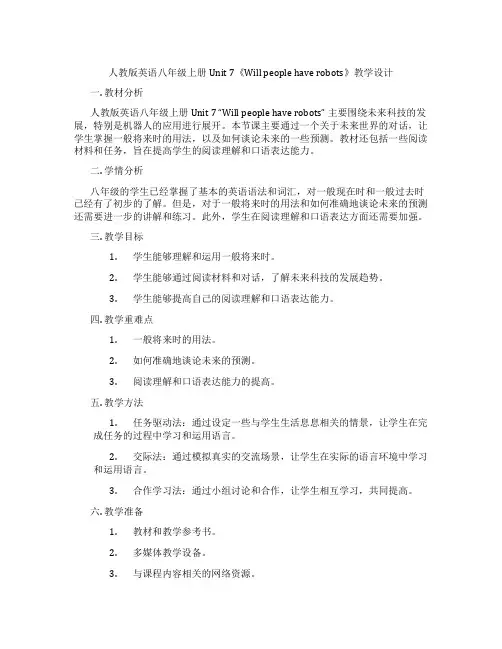
人教版英语八年级上册Unit 7《Will people have robots》教学设计一. 教材分析人教版英语八年级上册Unit 7 “Will people have robots” 主要围绕未来科技的发展,特别是机器人的应用进行展开。
本节课主要通过一个关于未来世界的对话,让学生掌握一般将来时的用法,以及如何谈论未来的一些预测。
教材还包括一些阅读材料和任务,旨在提高学生的阅读理解和口语表达能力。
二. 学情分析八年级的学生已经掌握了基本的英语语法和词汇,对一般现在时和一般过去时已经有了初步的了解。
但是,对于一般将来时的用法和如何准确地谈论未来的预测还需要进一步的讲解和练习。
此外,学生在阅读理解和口语表达方面还需要加强。
三. 教学目标1.学生能够理解和运用一般将来时。
2.学生能够通过阅读材料和对话,了解未来科技的发展趋势。
3.学生能够提高自己的阅读理解和口语表达能力。
四. 教学重难点1.一般将来时的用法。
2.如何准确地谈论未来的预测。
3.阅读理解和口语表达能力的提高。
五. 教学方法1.任务驱动法:通过设定一些与学生生活息息相关的情景,让学生在完成任务的过程中学习和运用语言。
2.交际法:通过模拟真实的交流场景,让学生在实际的语言环境中学习和运用语言。
3.合作学习法:通过小组讨论和合作,让学生相互学习,共同提高。
六. 教学准备1.教材和教学参考书。
2.多媒体教学设备。
3.与课程内容相关的网络资源。
七. 教学过程1.导入(5分钟)通过向学生展示一些机器人的图片,引起学生的兴趣,然后提问:“你们认为未来的人们会拥有机器人吗?”,让学生发表自己的看法。
2.呈现(10分钟)老师通过讲解和示范,向学生介绍一般将来时的用法,并举例说明如何准确地谈论未来的预测。
3.操练(10分钟)学生分组进行角色扮演,模拟真实的交流场景,运用一般将来时进行对话。
老师对学生的表现进行指导和评价。
4.巩固(10分钟)学生阅读教材中的阅读材料,理解并回答相关问题。
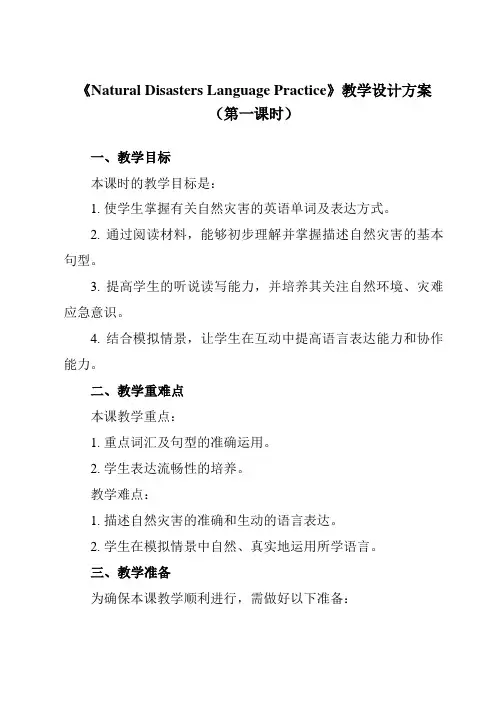
《Natural Disasters Language Practice》教学设计方案(第一课时)一、教学目标本课时的教学目标是:1. 使学生掌握有关自然灾害的英语单词及表达方式。
2. 通过阅读材料,能够初步理解并掌握描述自然灾害的基本句型。
3. 提高学生的听说读写能力,并培养其关注自然环境、灾难应急意识。
4. 结合模拟情景,让学生在互动中提高语言表达能力和协作能力。
二、教学重难点本课教学重点:1. 重点词汇及句型的准确运用。
2. 学生表达流畅性的培养。
教学难点:1. 描述自然灾害的准确和生动的语言表达。
2. 学生在模拟情景中自然、真实地运用所学语言。
三、教学准备为确保本课教学顺利进行,需做好以下准备:1. 教学课件:包含自然灾害相关图片和词汇,以及模拟情景对话的脚本。
2. 教学材料:阅读材料、练习册等。
3. 教学环境:准备多媒体教室,确保有投影仪和音响设备正常工作。
4. 学生准备:预习相关词汇,了解自然灾害的基本知识。
通过下一步可以按照如下内容继续书写:继续保障校园内的保有投影仪和音响设备能够正常工作,对于可能出现的故障应提前做好维护和检查,确保在教学和会议时能顺利进行。
对于教室的投影仪,应定期进行清洁和调试,确保投影效果清晰,音响设备则要保证声音清晰、音量适中。
同时,学生方面也要继续做好准备。
在课前预习相关词汇,了解自然灾害的基本知识,有助于他们在课堂上更好地理解和掌握知识。
在预习的过程中,学生可以查阅相关资料,了解自然灾害的成因、类型、影响以及应对措施等。
此外,他们还可以通过观看教学视频、阅读相关书籍等方式,加深对自然灾害的理解和认识。
总之,无论是设备保障还是学生准备,都是为了更好地进行教学和学习,为提升教育质量打下坚实的基础。
四、教学过程:本教学方案聚焦于中职英语课程《Natural Disasters Language Practice》的教学过程设计。
课程旨在通过英语语言学习,让学生掌握自然灾害相关的词汇和表达,并能够进行基本的交流和讨论。
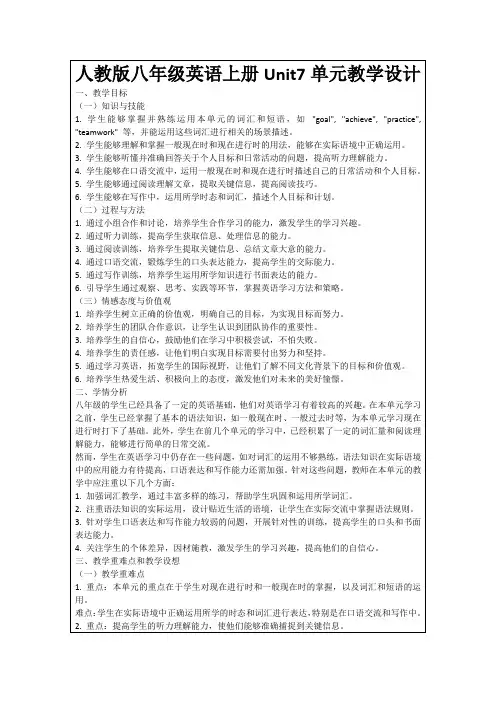
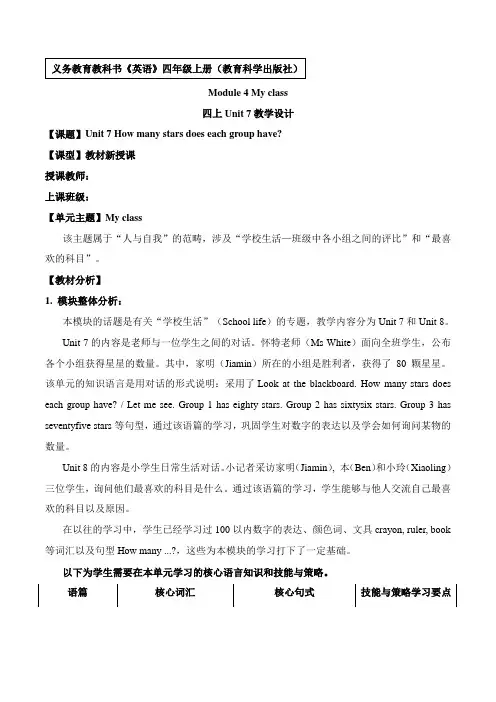
Module 4 My class四上Unit 7教学设计【课题】Unit 7 How many stars does each group have?【课型】教材新授课授课教师:上课班级:【单元主题】My class该主题属于“人与自我”的范畴,涉及“学校生活—班级中各小组之间的评比”和“最喜欢的科目”。
【教材分析】1. 模块整体分析:本模块的话题是有关“学校生活”(School life)的专题,教学内容分为Unit 7和Unit 8。
Unit 7的内容是老师与一位学生之间的对话。
怀特老师(Ms White)面向全班学生,公布各个小组获得星星的数量。
其中,家明(Jiamin)所在的小组是胜利者,获得了80颗星星。
该单元的知识语言是用对话的形式说明:采用了Look at the blackboard. How many stars does each group have? / Let me see. Group 1 has eighty stars. Group 2 has sixtysix stars. Group 3 has seventyfive stars等句型,通过该语篇的学习,巩固学生对数字的表达以及学会如何询问某物的数量。
Unit 8的内容是小学生日常生活对话。
小记者采访家明(Jiamin), 本(Ben)和小玲(Xiaoling)三位学生,询问他们最喜欢的科目是什么。
通过该语篇的学习,学生能够与他人交流自己最喜欢的科目以及原因。
在以往的学习中,学生已经学习过100以内数字的表达、颜色词、文具crayon, ruler, book 等词汇以及句型How many ...?,这些为本模块的学习打下了一定基础。
以下为学生需要在本单元学习的核心语言知识和技能与策略。
本节课Unit 7以对话展开,文章没有长难句,但学生要流利地朗读全文,并准确地运用词汇、短语和句型进行问答,有一定难度。
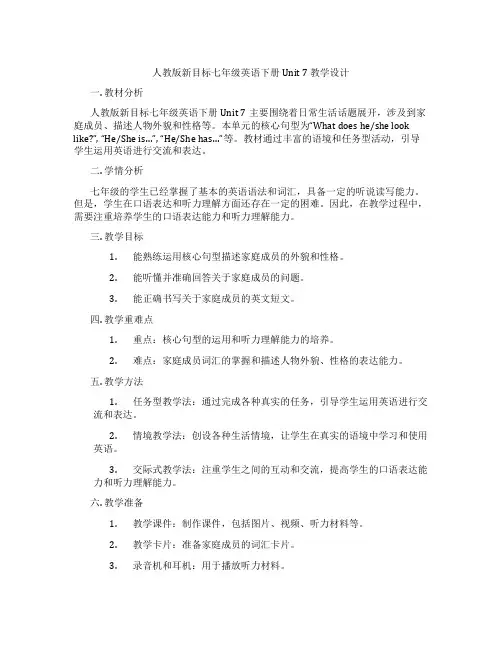
人教版新目标七年级英语下册 Unit 7 教学设计一. 教材分析人教版新目标七年级英语下册Unit 7主要围绕着日常生活话题展开,涉及到家庭成员、描述人物外貌和性格等。
本单元的核心句型为“What does he/she look like?”, “He/She is…”, “He/She has…”等。
教材通过丰富的语境和任务型活动,引导学生运用英语进行交流和表达。
二. 学情分析七年级的学生已经掌握了基本的英语语法和词汇,具备一定的听说读写能力。
但是,学生在口语表达和听力理解方面还存在一定的困难。
因此,在教学过程中,需要注重培养学生的口语表达能力和听力理解能力。
三. 教学目标1.能熟练运用核心句型描述家庭成员的外貌和性格。
2.能听懂并准确回答关于家庭成员的问题。
3.能正确书写关于家庭成员的英文短文。
四. 教学重难点1.重点:核心句型的运用和听力理解能力的培养。
2.难点:家庭成员词汇的掌握和描述人物外貌、性格的表达能力。
五. 教学方法1.任务型教学法:通过完成各种真实的任务,引导学生运用英语进行交流和表达。
2.情境教学法:创设各种生活情境,让学生在真实的语境中学习和使用英语。
3.交际式教学法:注重学生之间的互动和交流,提高学生的口语表达能力和听力理解能力。
六. 教学准备1.教学课件:制作课件,包括图片、视频、听力材料等。
2.教学卡片:准备家庭成员的词汇卡片。
3.录音机和耳机:用于播放听力材料。
七. 教学过程1.导入(5分钟)a.引导学生自由谈论自己的家庭成员。
b.出示一张家庭成员的图片,让学生用英语描述。
2.呈现(10分钟)a.展示教材中的图片,引导学生观察并描述家庭成员的外貌和性格。
b.教授核心句型“What does he/she look like?”, “He/She is…”,“He/She has…”等。
3.操练(10分钟)a.分组进行角色扮演,让学生模拟描述家庭成员的外貌和性格。
b.邀请几组学生上台表演,其他学生进行听力理解练习。

Unit 7 Natural Disasters教学设计(一)第一、第二课时Warming up and Listening and Speaking一、教材分析本课教学内容选自高等教育出版社出版的“十四五”职业教育国家规划教材,《英语3 基础模块》中Unit 7 Warming up and Listening and Speaking部分,听说部分要求学生能识别表示灾害的词汇,询问并回应因自然灾害导致航班延误的事件,并能就有关自然灾害的信息进行交流。
二、学情分析本单元主题为自然灾害,在课堂导入环节,需要学生调动已知的关于自然灾害的词汇,对于学生来说,了解常见的自然灾害难度不大,但是缺乏基本的词汇储备,用英语表达自然灾害存在一定的难度;部分学生了解常见的自然灾害相关词汇,但缺乏归纳总结,用英语谈论自然灾害的能力略显薄弱,需进一步强化与提高。
三、教学目标After leaning this lesson,students can通过本课的学习,学生能够1.identify the vocabulary of natural disasters and make a brief introduction.识别关于自然灾害的词汇,并做简单介绍;2.understand the reasons for flight cancellations and natural disasters.听懂航班取消的原因、自然灾害发生的原因;3. predict the listening content and summarize the theme. Ask and respond to the topic of natural disasters and human travel, and put forward their own views.根据问题和选项预测听力内容,在听的过程中概括主题,针对自然灾害和人类出行的话题进行询问和回应,并提出自己的观点;4. ask customers about the reasons for flight delays as hotel receptionists, improve their professional quality, and cultivate their ability to perceive differences in thinking and cross-cultural understanding.学生能够以酒店接待人的身份,询问顾客航班延误的原因,提升职业素养,培养思维差异感知能力和跨文化理解能力。
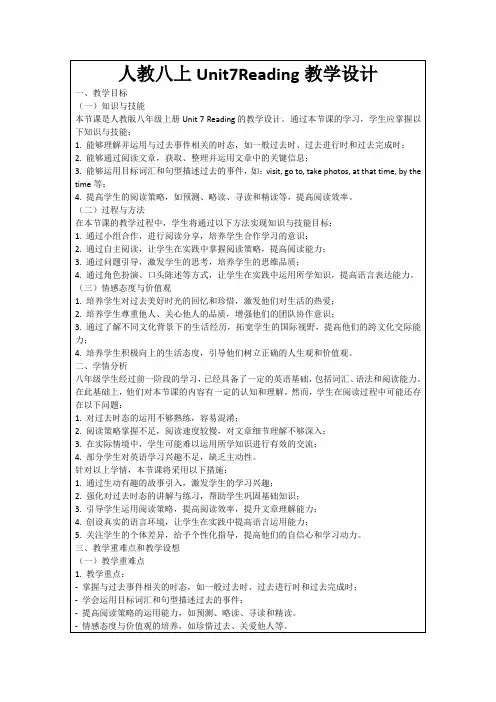
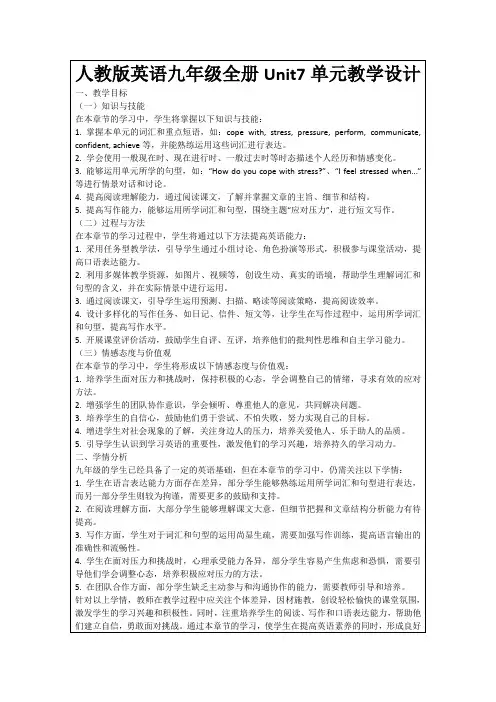
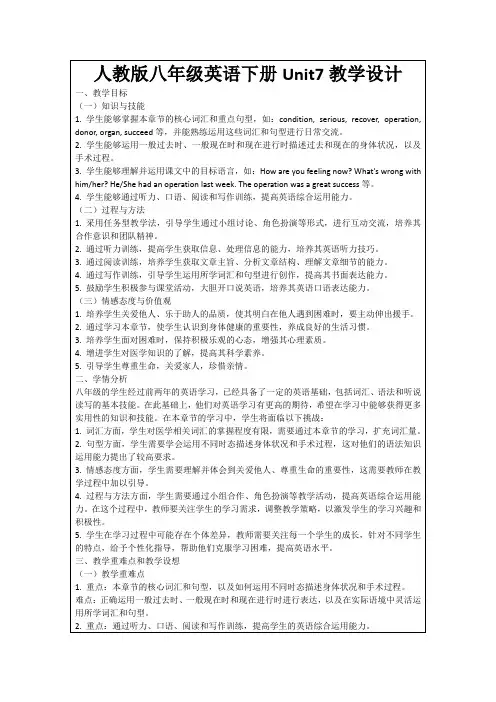
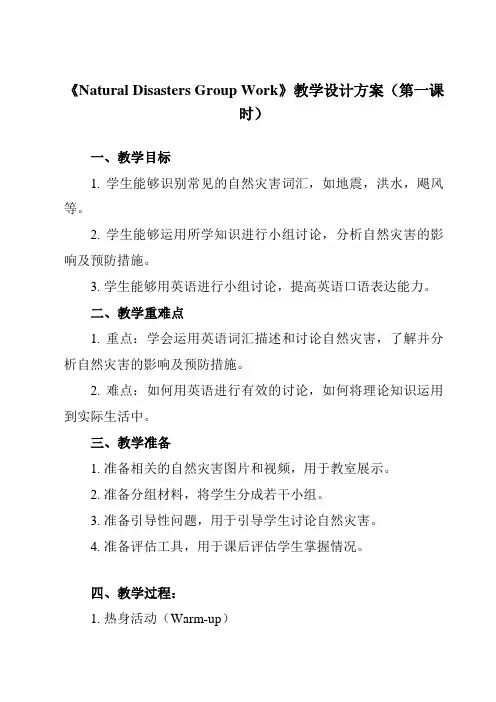
《Natural Disasters Group Work》教学设计方案(第一课时)一、教学目标1. 学生能够识别常见的自然灾害词汇,如地震,洪水,飓风等。
2. 学生能够运用所学知识进行小组讨论,分析自然灾害的影响及预防措施。
3. 学生能够用英语进行小组讨论,提高英语口语表达能力。
二、教学重难点1. 重点:学会运用英语词汇描述和讨论自然灾害,了解并分析自然灾害的影响及预防措施。
2. 难点:如何用英语进行有效的讨论,如何将理论知识运用到实际生活中。
三、教学准备1. 准备相关的自然灾害图片和视频,用于教室展示。
2. 准备分组材料,将学生分成若干小组。
3. 准备引导性问题,用于引导学生讨论自然灾害。
4. 准备评估工具,用于课后评估学生掌握情况。
四、教学过程:1. 热身活动(Warm-up)在课程开始时,我会引导学生进行一些轻松的互动活动,例如描述自然灾害的词汇联想,以此来帮助他们熟悉即将学习的主题。
2. 导入新课(Presentation)接下来,我会通过一些图片和视频来介绍一些常见的自然灾害,并诠释它们是如何发生的。
同时,我会介绍一些应对这些灾害的策略,帮助学生建立初步的灾害应对认识。
3. 分组活动(Group Work)分组活动是本课的核心部分。
我将根据学生的英语水平、性格特点等因素进行分组,确保每个小组都有不同水平的学生。
每个小组都需要选择一种特定的自然灾害(例如地震、洪水、龙卷风等),并讨论如何在内地区预防和应对这种灾害。
在此过程中,我会提供一些引导性问题,以帮助学生深入讨论。
4. 展示和分享(Presentation and Sharing)每个小组完成讨论后,我会邀请他们向全班展示他们的效果。
他们可以展示海报、PPT、录像或表演等形式的作品,展示内容包括如何预防灾害、如何应对灾害等。
这一环节有助于提高学生的团队协作能力和口语表达能力。
5. 反馈和评判(Feedback and Evaluation)最后,我会对学生的展示进行反馈和评判,指出他们的优点和需要改进的地方。
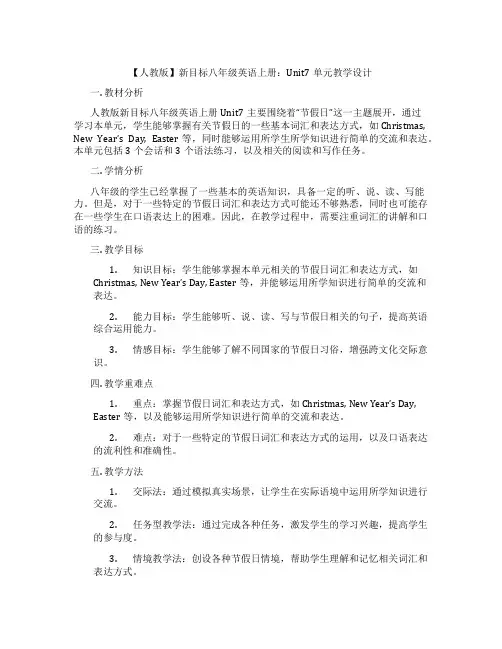
【人教版】新目标八年级英语上册:Unit7单元教学设计一. 教材分析人教版新目标八年级英语上册Unit7主要围绕着“节假日”这一主题展开,通过学习本单元,学生能够掌握有关节假日的一些基本词汇和表达方式,如Christmas, New Year’s Day, Easter等,同时能够运用所学生所学知识进行简单的交流和表达。
本单元包括3个会话和3个语法练习,以及相关的阅读和写作任务。
二. 学情分析八年级的学生已经掌握了一些基本的英语知识,具备一定的听、说、读、写能力。
但是,对于一些特定的节假日词汇和表达方式可能还不够熟悉,同时也可能存在一些学生在口语表达上的困难。
因此,在教学过程中,需要注重词汇的讲解和口语的练习。
三. 教学目标1.知识目标:学生能够掌握本单元相关的节假日词汇和表达方式,如Christmas, New Year’s Day, Easter等,并能够运用所学知识进行简单的交流和表达。
2.能力目标:学生能够听、说、读、写与节假日相关的句子,提高英语综合运用能力。
3.情感目标:学生能够了解不同国家的节假日习俗,增强跨文化交际意识。
四. 教学重难点1.重点:掌握节假日词汇和表达方式,如Christmas, New Year’s Day,Easter等,以及能够运用所学知识进行简单的交流和表达。
2.难点:对于一些特定的节假日词汇和表达方式的运用,以及口语表达的流利性和准确性。
五. 教学方法1.交际法:通过模拟真实场景,让学生在实际语境中运用所学知识进行交流。
2.任务型教学法:通过完成各种任务,激发学生的学习兴趣,提高学生的参与度。
3.情境教学法:创设各种节假日情境,帮助学生理解和记忆相关词汇和表达方式。
六. 教学准备1.教师准备:准备好相关的教学材料,如PPT、单词卡片、练习册等。
2.学生准备:学生预习本单元内容,完成相关的预习任务。
七. 教学过程1.导入(5分钟)通过提问方式引导学生谈论他们喜欢的节假日,激发学生的兴趣和积极性。
Unit7 Happy Birthday(教学设计)2024-2025学年译林版(三起)2024英语三年级上册一、教学目标知识目标:学生能够听懂、会说、认读并书写与生日相关的单词,如happy, birthday, cake, gift等。
学生能够正确理解并口头运用生日祝福和接受礼物的交际用语,如“Happy birthday!”, “This is for you.”, “Thank you.”等。
能力目标:学生能够在模拟的生日场景中运用所学词汇和句型进行简单的英语交流。
提高学生的英语口语表达能力和听力理解能力。
情感目标:激发学生学习英语的兴趣,增强他们在英语学习中的自信心。
培养学生的合作意识和团队精神,通过小组活动增进同学间的友谊。
二、教学内容分析本单元以“Happy Birthday”为主题,围绕生日庆祝活动展开,涉及生日祝福、赠送礼物、唱生日歌等日常交际用语。
通过本单元的学习,学生将掌握与生日相关的基本词汇和句型,提高在特定情境下的英语交际能力。
三、学情分析三年级学生处于英语学习的初级阶段,他们好奇心强,喜欢参与各种有趣的活动。
经过前两个单元的学习,学生已经掌握了一些基础的英语词汇和句型,但他们的口语表达能力和听力理解能力仍需进一步提高。
此外,学生对生日庆祝活动非常感兴趣,这将有助于他们积极参与课堂活动,提高学习效果。
四、教学方法与手段情境创设法:通过模拟生日场景,让学生在真实的情境中学习和运用英语。
游戏教学法:利用游戏激发学生的学习兴趣,提高他们在课堂上的参与度。
小组合作学习:通过小组合作,培养学生的合作意识和团队精神,同时让他们在交流中提高英语口语能力。
多媒体辅助教学:利用多媒体课件、音频和视频资源,丰富课堂内容,提高教学效果。
五、教学重难点教学重点:学生能够听懂、会说、认读并书写与生日相关的单词和句型。
教学难点:在模拟的生日场景中灵活运用所学词汇和句型进行英语交流。
六、教学过程Step 1: Warm-up (5分钟)活动:播放英文生日歌曲《Happy Birthday》,全班学生跟着唱,营造生日氛围。
《Invention and Innovation Group Work》教学设计方案(第一课时)一、教学目标1. 学生能够理解和使用与发明与创新相关的基本英语词汇和短语。
2. 培养学生的团队协作和沟通能力,提高他们在小组工作中的创新思维。
3. 激发学生对发明与创新的兴趣,培养他们的创新意识和精神。
二、教学重难点1. 重点:理解和使用与发明与创新相关的英语词汇和短语,进行有效的团队协作和沟通。
2. 难点:在小组工作中运用创新思维,解决实际问题。
三、教学准备1. 准备与发明与创新、小组工作相关的英语词汇和短语卡片。
2. 准备小组活动所需的道具和材料。
3. 提前布置小组讨论的主题,以便学生有足够的时间准备。
4. 邀请有发明和创新经验的学生或老师分享他们的经验和故事。
四、教学过程:本节课的教学设计以Invention and Innovation Group Work为主题,通过引导学生开展小组讨论、合作探究等活动,旨在培养学生的创新思维和团队合作精神。
1. 导入环节:通过展示一些具有创新性的发明和创新的图片,引导学生思考这些发明和创新的特点,并引出本节课的主题。
2. 分组活动:将学生分成若干小组,每组选出一名组长,并分配不同的任务。
任务包括收集相关资料、组织讨论、汇报成果等。
3. 讨论与探究:学生围绕主题展开讨论,分享自己的想法和观点,并尝试从不同的角度分析问题。
教师给予必要的引导和提示,帮助学生发散思维。
4. 成果展示:各小组派代表汇报本组的讨论成果,展示小组合作成果。
教师和其他学生可提出问题和建议,给予反馈和指导。
5. 评价与反思:教师对各小组的表现进行评价,总结学生的创新思维和团队合作精神,同时引导学生反思自己在活动中的表现,总结经验教训。
6. 课堂延伸:鼓励学生课后继续关注创新和发明的话题,利用网络资源进一步了解相关知识和案例,并在今后的学习和生活中尝试运用创新思维解决问题。
在具体的教学过程中,教师还需要注意以下几点:1. 合理分组:根据学生的兴趣爱好、能力水平等因素进行分组,确保各小组之间的实力均衡,同时鼓励跨组合作和交流。
Unit7 How do you make banana milk shake?section A(1a-2c)
教学目标:
1、New words:shake,blender,cut,peel,pour,yogurt,ingredient,
watermelon,teaspoon,amount,instruction
2、Key phrases:turn on,cut up,pour… into…
3、Key sentences: How do you make a banana milk shake?
How many bananas do we need?
How much yogurt do we need?
能力目标:学会使用first,next,then,finally副词和动词短语来描述做一件事的过程
情感目标:学会询问并了解做事的过程
教学重点:掌握运用first,next,then and finally这些副词描述做事的过程及turn on,cut up…等动词短语。
教学难点:动词短语,可数名词与不可数名词的用法。
教学方法:演示法,游戏,任务型语言教学法,创设情境法
学习方法:自主、合作、交流、探究
教学过程(teaching procedures)
Step1. Warming-up
Check students have previewed the new words.
1.Get several students to read aloud the words and help them get the
pronunciation right. And then follow to read after the teacher.
2.Check the some exercise in group. If necessary, give the students a
hand.
Step2. lead into the new lesson.
1. Discuss their favorite drink with the students by asking:
Do you like drink orange juice? What’s your favorite dink?
Show the students a picture of milk shake.Then lead into the new lesson. What’s this?
It’s a kind of special and delicious drink,it’s western drink .of course,we can drink it in KFC.
Do you want to drink banana milk shake? Now let’s make it together.
2. Show different kinds of milk shake to the students.
Step3. Pre—task
1.the students look at the picture of making banana milk shake, then
discuss the key verb phrases and process of making banana milk shake 2.Get some students to write some key verb phrases quickly in the
picture on page41.
3. Ask the students to discuss a question: what do we need if we want to make banana milk shake? Then say out some ingredients and tools with CAI. Ingredients: bananas milk/yogurt ice cream
tools: blender knife cup
4.Introduce the key words and verb phrases with pictures, and demonstrate the process of making banana milk shake.
First, peel three bananas. Next,cut up the bananas. Next, put the bananas and ice cream into the blender. Next, pour the milk into the blender. Then, turn on the blender. Finally, drink the milk shake. Explain the usage of verb phrases to the students.( turn on/ turn off; turn down/ turn up)
Step 4 While-task
1.Get the students to retell the process of making banana milk shake according to the pictures individually.
2.Listen to the conversation about making banana milk shake and put the sentences in the right order that they hear. After that check their answers.
3.Get several students to try to read the chant on the screen. Then ask them to chant the actions for making banana milk shake.
Peel,peel,peel the banana. Cut,cut,cut up the banana.
Pour,pour,pour the milk. Turn,turn,turn on the blender Step 5 Post-task
1. Group work. The students in group take turns to talk about the process of making banana milk shake.
Student1: how do you make banana milk shake ?
Student2: well, first, peel a banana
Student3: next, cut up ...
2.Show the students a picture of salad. then look at the pictures and discuss : what do we need if we make fruit salad ( honey, yogurt, teaspoon, banana, strawberry, oranges and apple)
3.Call the students focus on 2a and 2b on page42. Explain the key words and get the students to talk about how many.../how much...?, then complete the chart in 2a and 2b after they hear the conversation. Check their answers.
4.Pair work. Ask the students in pairs to talk about how to make fruit salad.( explain the meaning of mix up)
5.Fill in the blanks with first, next, then and finally, retell the process of making fruit salad.
Step 6 Summary and extension
1.Get several students to talk about what we have learned in this lesson.
2.The students complete some exercise and check their answers in class Writing design
Unit7 how do you make banana milk shake?
V erb phases: peel, cut up, put... Into... pour... into... turn on / turn off...
Some adverbs: first, next, then, finally.
The process of making banana milk shake: first, peel the banana, next, cut up the banana, next, put ... into...。